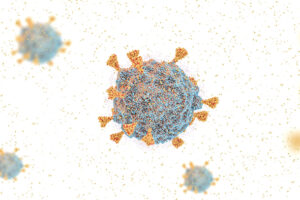Infectious Diseases
Influenza
The Red Book Committee: Questions and Answers
Overview
In a live session titled “Meet the Red Book Committee” at the 2020 AAP Virtual National Conference & Exhibition, Mary T. Caserta, MD, FAAP, Yvonne A. Maldonado, MD, FAAP, and Sean O’Leary, MD, MPH, reviewed updates on immunization recommendations and other diagnostic and management issues that are important in pediatric infectious disease. The session live-streamed at 10 AM CDT on Monday, October 5.
Following the presentation, our featured experts, Sean O’Leary, MD, MPH, and Mark H. Sawyer, MD, FAAP, FIDSA, were interviewed by Conference Reporter Editor-in-Chief Tom Iarocci, MD. Their clinical perspectives on this session are presented here.
Sean O'Leary, MD, MPH
|
|
“We are learning more about COVID-19 transmission dynamics with time, and the AAP has strongly advocated that all policy considerations for school operations should start with the goal of having students be physically present in school.”
The Red Book covers a number of infectious diseases in pediatrics, and there is a focus on topics that are day-to-day problems and challenges for pediatricians. The Red Book Committee is also concerned with these issues. School operation during COVID-19 is a topic of interest to the committee and to the general public. I was the Committee on Infectious Diseases’ representative for the American Academy of Pediatrics (AAP), working with the Council on School Health and others to develop the guidance, and it has been a journey. We are learning more about COVID-19 transmission dynamics with time, and the AAP has strongly advocated that all policy considerations for school operations should start with the goal of having students be physically present in school. Although there continues to be some uncertainty, accumulating evidence shows that younger children of prekindergarten and elementary school age appear to be both less likely to get COVID-19 and less likely to spread the infection to others. We are still trying to understand why that might be. Older children and adolescents appear to be more likely than younger children to become infected. For schools currently offering only all-remote instruction, decisions about reopening should follow a phased approach in accordance with the local epidemiology. In certain places, I believe that it is likely safe for even high school students to attend school, provided that strict mitigation measures are in place. Staff and teachers are an especially important consideration in these decisions, as they are at higher risk of severe disease. Many of the outbreaks we are seeing in schools at this point are among teachers, for example, as a result of in-person meetings. The AAP guidance continues to advocate for virtual staff meetings, as that problem was predictable. We will continue to update further AAP guidance on COVID-19 as new information becomes available.
The importance of getting an influenza vaccine should also be stressed. The low burden of influenza in the southern hemisphere this season, along with concerns about waning antibody titers several weeks after vaccination, have led some clinicians to ask whether delaying influenza vaccination is advisable. While we would hope for a similar experience as the southern hemisphere, with low rates of influenza perhaps due to COVID-19 mitigation efforts, we cannot expect that this experience will be replicated here. The downside of trying to delay vaccination is that it has been estimated that a large number of people would not get vaccinated in time—or at all—before flu season hits. So, the theoretical incremental gain you might get from having higher titers to coincide with the peak of the flu season would be diminished by lower vaccine coverage rates at the same time span.
Mark H. Sawyer, MD, FAAP, FIDSA
|
|
“Of the 3 infections discussed in this session (ie, RSV, influenza, and COVID-19), only influenza can be easily prevented with a vaccine at this time.”
Speakers representing the Red Book Committee discussed the following 3 infections: respiratory syncytial virus (RSV), influenza, and COVID-19. RSV and influenza are well known to peak in the wintertime, and we are now adding COVID-19 into that mix. Since all 3 are going to be co-circulating, diagnosis, quarantine decisions, and testing decisions will be challenging. Of the 3 infections discussed in this session, only influenza can be easily prevented with a vaccine at this time. There are some promising future interventions with RSV, such as a pregnancy-based RSV vaccine to note, and we have talked about COVID-19 vaccine development at great length elsewhere. Dr O’Leary did a nice job of explaining why it is important for everybody to get an influenza vaccine this year. It is important to highlight that between 50 and 150 children die of influenza in the United States each year. Most of these deaths occur in those who are unimmunized, and approximately half of them occur in healthy children with no underlying conditions that put them at risk.
Early on in the COVID-19 outbreak, many clinics were closed, and people did not get their routine vaccinations. Even in settings where clinics were open, many individuals did not come in due to concerns about COVID-19. So, there is a big deficit in immunizations that were missed, and that is something that we need to make up. Many parents returned recently for vaccinations because of school requirements, but people are still somewhat hesitant. Regarding school reopenings, I think that a phased approach with gradually opening schools rather than opening every school all at once makes the most sense. The strategy of starting with younger children is rational given their increased need, their decreased ability to do online education, and the data about decreased transmission in that age group. College campuses are a particular challenge because that involves an age group that is not known to be particularly compliant. We will have to follow that population closely.
References
American Academy of Pediatrics. COVID-19 planning considerations: guidance for school re-entry. Accessed October 15, 2020. https://services.aap.org/en/pages/2019-novel-coronavirus-covid-19-infections/clinical-guidance/covid-19-planning-considerations-return-to-in-person-education-in-schools/
Caserta MT, Maldonado YA, O’Leary ST. Meet the Red Book Committee. Live session presented at: 2020 American Academy of Pediatrics Virtual National Conference & Exhibition; October 2-5, 2020.
Centers for Disease Control and Prevention. Coronavirus disease 2019 (COVID-19). Information for pediatric healthcare providers. Accessed October 15, 2020. https://www.cdc.gov/coronavirus/2019-ncov/hcp/pediatric-hcp.html
Centers for Disease Control and Prevention. Laboratory-confirmed influenza hospitalizations: preliminary cumulative rates as of Oct 03, 2020. Accessed October 15, 2020. https://gis.cdc.gov/grasp/fluview/fluhosprates.html
Committee on Infectious Diseases. Recommendations for prevention and control of influenza in children, 2020-2021. Pediatrics. 2020;146(4):e20220024588. doi:10.1542/peds.2020-024588
Flannery B, Reynolds SB, Blanton L, et al. Influenza vaccine effectiveness against pediatric deaths: 2010-2014. Pediatrics. 2017;139(5):e20164244. doi:10.1542/peds.2016-4244
Lee B, Raszka WV Jr. COVID-19 in children: looking forward, not back. Pediatrics. 2020 Oct 8;e2020029736. doi:10.1542/peds.2020-029736
This information is brought to you by Engage Health Media and is not sponsored by, nor a part of, the American Academy of Pediatrics.












